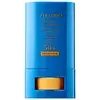What's inside
What's inside
 Key Ingredients
Key Ingredients

 Benefits
Benefits

 Concerns
Concerns

 Ingredients Side-by-side
Ingredients Side-by-side

Water
Skin ConditioningC12-15 Alkyl Benzoate
AntimicrobialTitanium Dioxide
Cosmetic ColorantPropanediol
SolventButyloctyl Salicylate
Skin ConditioningNiacinamide
SmoothingCaprylyl Methicone
Skin ConditioningCaprylic/Capric Triglyceride
MaskingPolyhydroxystearic Acid
EmulsifyingAluminum Stearate
Cosmetic Colorant1,2-Hexanediol
Skin ConditioningPentylene Glycol
Skin ConditioningPolymethylsilsesquioxane
Guaiazulene
AntimicrobialAlumina
AbrasiveAmmonium Acryloyldimethyltaurate/Vp Copolymer
Polyacrylate Crosspolymer-6
Emulsion StabilisingCetyl Hydroxyethylcellulose
Emulsion StabilisingCellulose Gum
Emulsion StabilisingHydroxypropyl Methylcellulose
Emulsion StabilisingSodium Stearoyl Glutamate
CleansingButylene Glycol
HumectantStearic Acid
CleansingEthylhexylglycerin
Skin ConditioningAdenosine
Skin ConditioningT-Butyl Alcohol
PerfumingGlycerin
HumectantPanthenol
Skin ConditioningArbutin
AntioxidantHydrogenated Lecithin
EmulsifyingCetearyl Alcohol
EmollientBifida Ferment Lysate
Skin ConditioningGlycyrrhiza Glabra Root Extract
BleachingMorus Alba Bark Extract
Skin ConditioningCentella Asiatica Extract
CleansingVaccinium Myrtillus Fruit/Leaf Extract
AstringentPrimula Veris Extract
Skin ConditioningPrunus Serrulata Flower Extract
Skin ConditioningMoringa Oleifera Seed Extract
Skin ConditioningLavandula Angustifolia Flower Extract
CleansingCalendula Officinalis Flower Extract
MaskingCamellia Sinensis Leaf Extract
AntimicrobialPortulaca Oleracea Extract
Skin ConditioningOryza Sativa Extract
AbsorbentMelaleuca Alternifolia Leaf Extract
PerfumingCitrus Limon Fruit Extract
MaskingCeramide NP
Skin ConditioningPotassium Sorbate
PreservativeHydroxypropyl Cyclodextrin
MaskingCeramide Ns
Skin ConditioningPhytosphingosine
Skin ConditioningCholesterol
EmollientHyaluronic Acid
HumectantCeramide As
Skin ConditioningCeramide AP
Skin ConditioningGlutathione
Disodium EDTA
Hydrolyzed Hyaluronic Acid
HumectantSodium Hyaluronate
HumectantCeramide EOP
Skin ConditioningUltramarines
Parfum
MaskingWater, C12-15 Alkyl Benzoate, Titanium Dioxide, Propanediol, Butyloctyl Salicylate, Niacinamide, Caprylyl Methicone, Caprylic/Capric Triglyceride, Polyhydroxystearic Acid, Aluminum Stearate, 1,2-Hexanediol, Pentylene Glycol, Polymethylsilsesquioxane, Guaiazulene, Alumina, Ammonium Acryloyldimethyltaurate/Vp Copolymer, Polyacrylate Crosspolymer-6, Cetyl Hydroxyethylcellulose, Cellulose Gum, Hydroxypropyl Methylcellulose, Sodium Stearoyl Glutamate, Butylene Glycol, Stearic Acid, Ethylhexylglycerin, Adenosine, T-Butyl Alcohol, Glycerin, Panthenol, Arbutin, Hydrogenated Lecithin, Cetearyl Alcohol, Bifida Ferment Lysate, Glycyrrhiza Glabra Root Extract, Morus Alba Bark Extract, Centella Asiatica Extract, Vaccinium Myrtillus Fruit/Leaf Extract, Primula Veris Extract, Prunus Serrulata Flower Extract, Moringa Oleifera Seed Extract, Lavandula Angustifolia Flower Extract, Calendula Officinalis Flower Extract, Camellia Sinensis Leaf Extract, Portulaca Oleracea Extract, Oryza Sativa Extract, Melaleuca Alternifolia Leaf Extract, Citrus Limon Fruit Extract, Ceramide NP, Potassium Sorbate, Hydroxypropyl Cyclodextrin, Ceramide Ns, Phytosphingosine, Cholesterol, Hyaluronic Acid, Ceramide As, Ceramide AP, Glutathione, Disodium EDTA, Hydrolyzed Hyaluronic Acid, Sodium Hyaluronate, Ceramide EOP, Ultramarines, Parfum
Butyl Methoxydibenzoylmethane 2.5%
UV AbsorberHomosalate 10%
Skin ConditioningEthylhexyl Methoxycinnamate 4.9%
UV AbsorberEthylhexyl Salicylate 5%
UV AbsorberOctocrylene 5%
UV AbsorberBenzophenone-3 3%
UV AbsorberDiphenylsiloxy Phenyl Trimethicone
Skin ConditioningTriethylhexanoin
MaskingParaffinum Liquidum
EmollientHydroxystearic Acid
CleansingDibutyl Lauroyl Glutamide
Skin ConditioningPolyamide-8
EmollientPEG/PPG-14/7 Dimethyl Ether
Skin ConditioningLecithin
EmollientGlycyrrhiza Glabra Root Extract
BleachingPPG-17
Skin ConditioningSilica Dimethyl Silylate
EmollientBHT
AntioxidantTocopherol
AntioxidantPentaerythrityl Tetra-Di-T-Butyl Hydroxyhydrocinnamate
AntioxidantParfum
MaskingButyl Methoxydibenzoylmethane 2.5%, Homosalate 10%, Ethylhexyl Methoxycinnamate 4.9%, Ethylhexyl Salicylate 5%, Octocrylene 5%, Benzophenone-3 3%, Diphenylsiloxy Phenyl Trimethicone, Triethylhexanoin, Paraffinum Liquidum, Hydroxystearic Acid, Dibutyl Lauroyl Glutamide, Polyamide-8, PEG/PPG-14/7 Dimethyl Ether, Lecithin, Glycyrrhiza Glabra Root Extract, PPG-17, Silica Dimethyl Silylate, BHT, Tocopherol, Pentaerythrityl Tetra-Di-T-Butyl Hydroxyhydrocinnamate, Parfum
 Reviews
Reviews

Ingredients Explained
These ingredients are found in both products.
Ingredients higher up in an ingredient list are typically present in a larger amount.
Glycyrrhiza Glabra Root Extract is an extract of the roots of Licorice. It has been found to have several benefits such as skin hydrating, conditioning, and soothing.
One component, glabridin, has extra potent antioxidant and soothing properties. It has also been found to block pigmentation from UVB rays in guinea pigs.
Licorice Root also contains a flavonoid. Flavonoids are a natural substance from in plants. Flavonoids also have antioxidant properties.
Another component, glycyrrhizin, has been found to have anti-inflammatory and antimicrobial benefits. This may make licorice root extract effective at treating acne. However, more research is needed to support this.
Liquiritin is one of the flavone compounds found in licorice. It has been found to help lighten skin by preventing tyrosinase from reacting with tyrosine. When the two react, protein is converted to melanin. Melanin is the substance in your body that gives your features pigmentation.
Learn more about Glycyrrhiza Glabra Root ExtractParfum is a catch-all term for an ingredient or more that is used to give a scent to products.
Also called "fragrance", this ingredient can be a blend of hundreds of chemicals or plant oils. This means every product with "fragrance" or "parfum" in the ingredients list is a different mixture.
For instance, Habanolide is a proprietary trade name for a specific aroma chemical. When used as a fragrance ingredient in cosmetics, most aroma chemicals fall under the broad labeling category of “FRAGRANCE” or “PARFUM” according to EU and US regulations.
The term 'parfum' or 'fragrance' is not regulated in many countries. In many cases, it is up to the brand to define this term.
For instance, many brands choose to label themselves as "fragrance-free" because they are not using synthetic fragrances. However, their products may still contain ingredients such as essential oils that are considered a fragrance by INCI standards.
One example is Calendula flower extract. Calendula is an essential oil that still imparts a scent or 'fragrance'.
Depending on the blend, the ingredients in the mixture can cause allergies and sensitivities on the skin. Some ingredients that are known EU allergens include linalool and citronellol.
Parfum can also be used to mask or cover an unpleasant scent.
The bottom line is: not all fragrances/parfum/ingredients are created equally. If you are worried about fragrances, we recommend taking a closer look at an ingredient. And of course, we always recommend speaking with a professional.
Learn more about Parfum